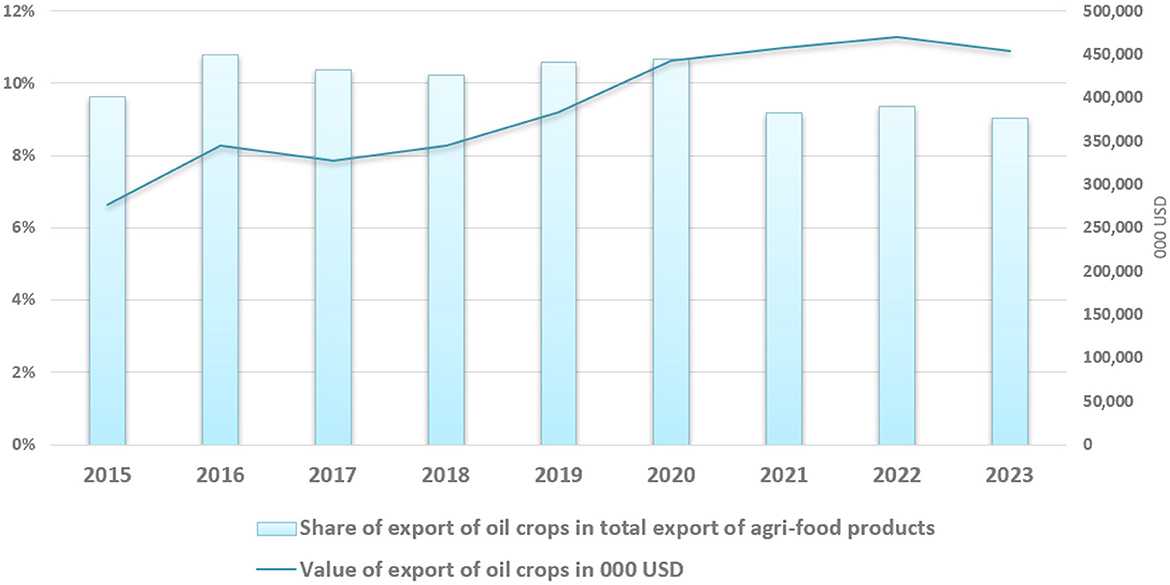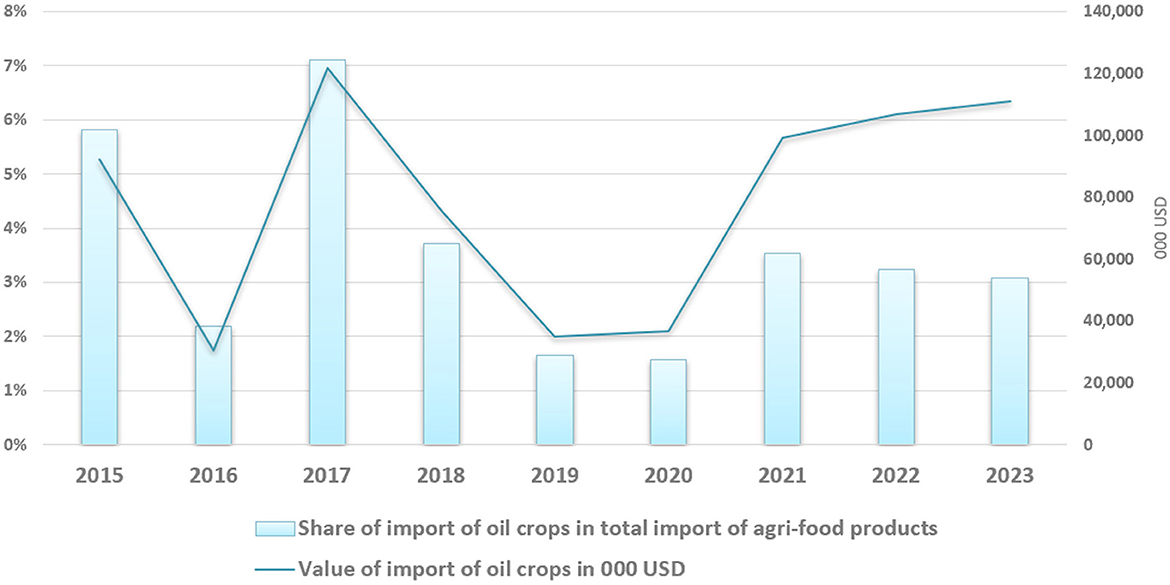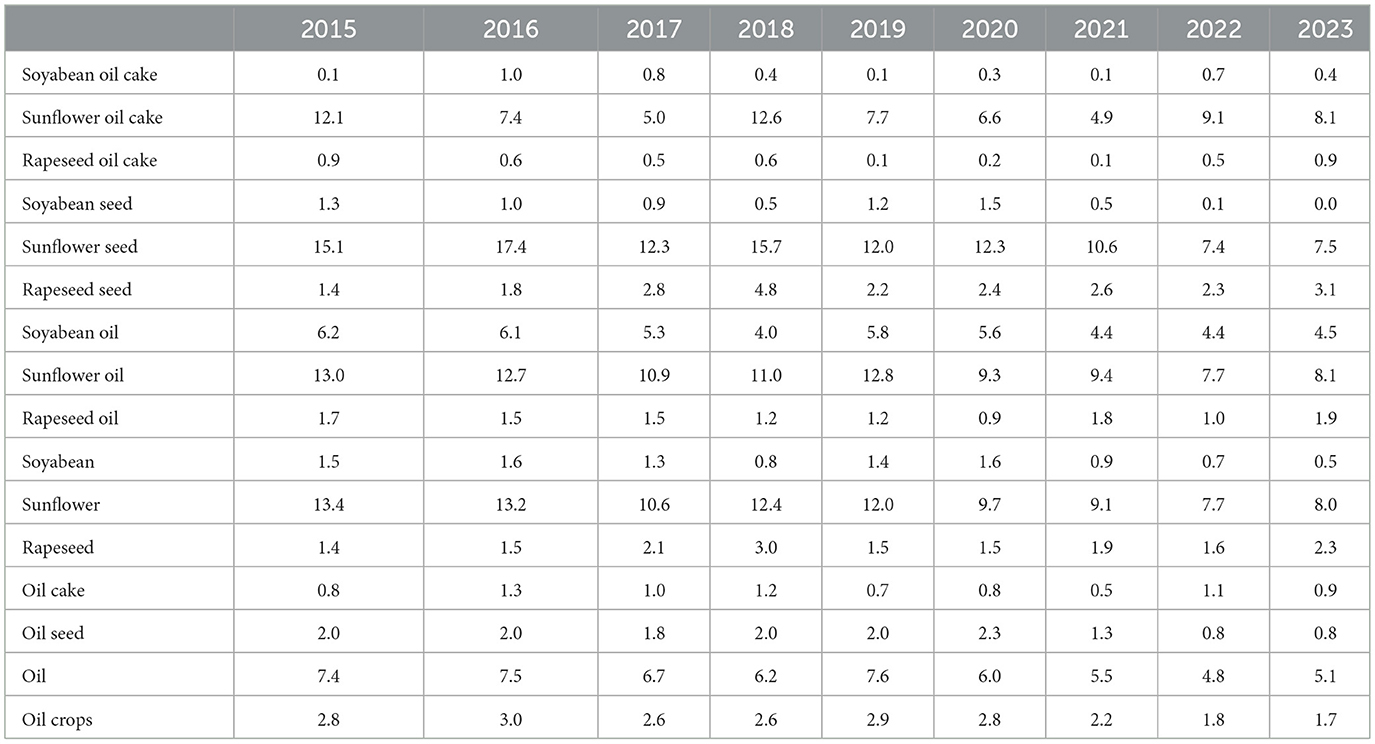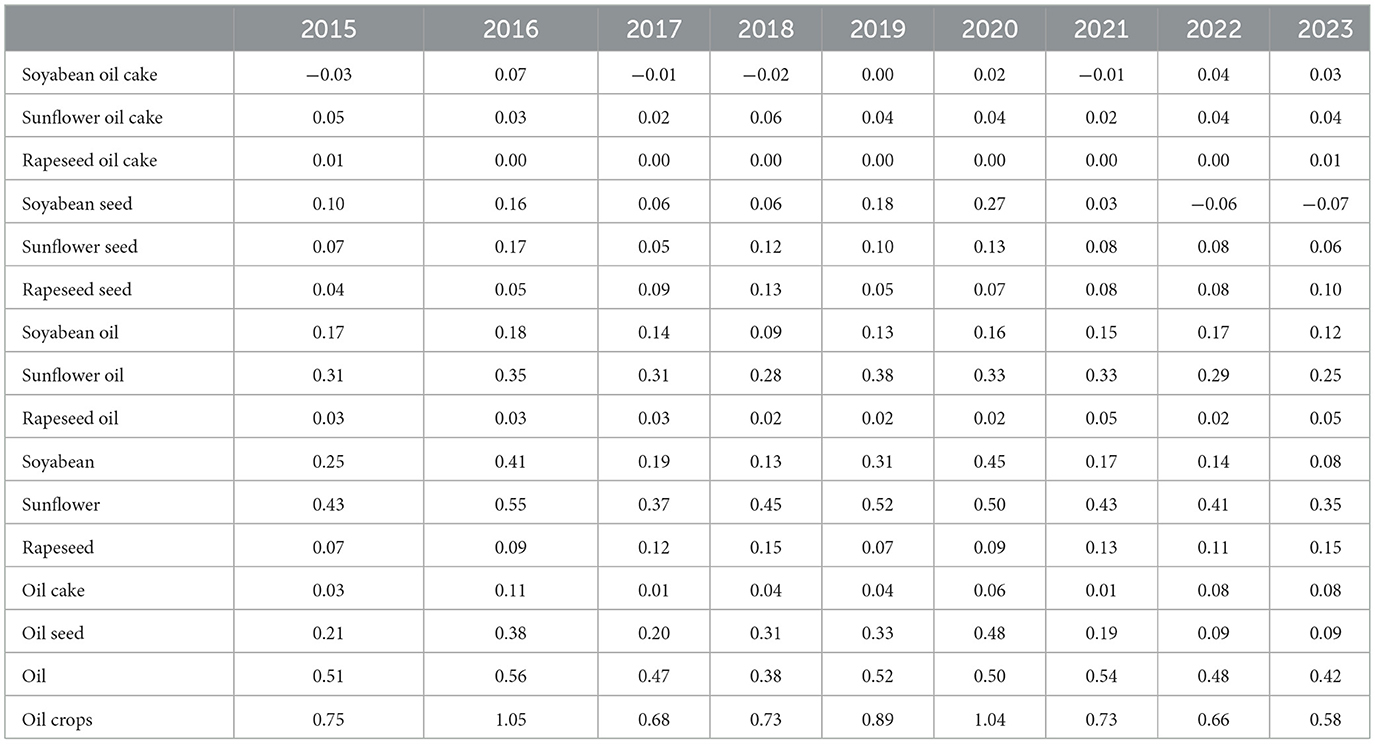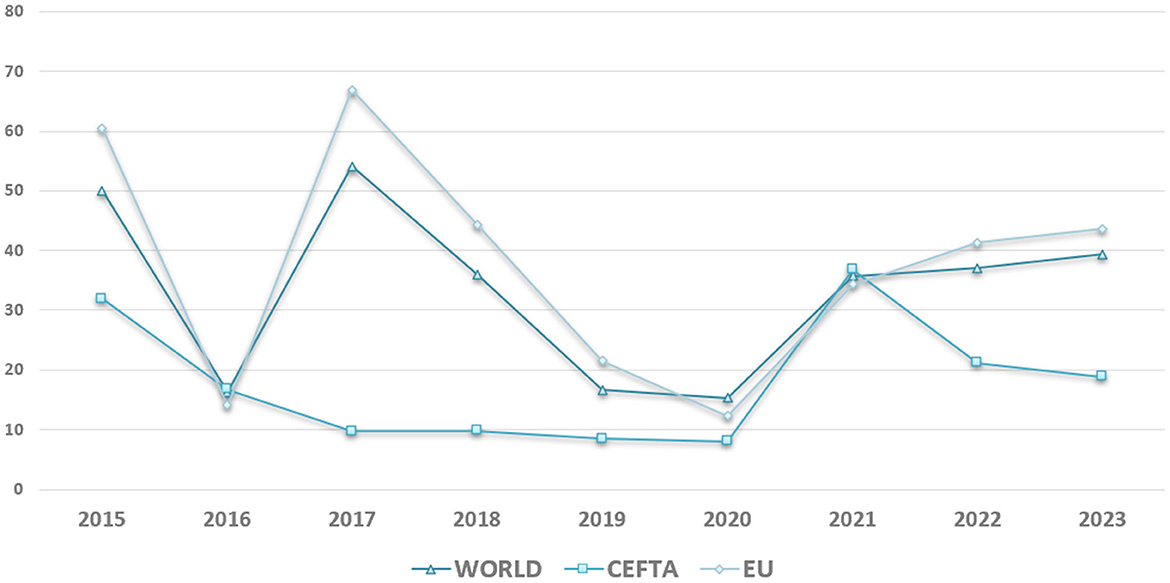- Department of Agricultural Economics and Agribusiness, Faculty of Economics in Subotica, University of Novi Sad, Subotica, Serbia
After cereals, oil crops are the most important group of crops in the world, and in Serbia, sunflower and soybeans, as well as their products, have the largest share in production and foreign trade of oil crops. Serbia is practically the leader in the Western Balkan region in the production of oil crops. Considering that in the last few years there have been various disturbances in the world market of oil crops, the aim of this paper is to look at the competitive positions of Serbia. In this direction, the production and foreign trade tendencies will be estimated, and the positions on the world market will be determined by the methods of revealed comparative advantages and level of specialization. The results of the research show that the competitive position of oil crops from Serbia on the international market is satisfactory, and it is primarily exported to the markets of the European Union and CEFTA countries. Oil crops make up about 10% of agri-food export from Serbia, and the best comparative advantages are observed in sunflowers, both sunflower oil and sunflower seeds. When it comes to the integration of the oil crops market with the world market, the highest degree of integration is observed with the countries of the European Union, with which the largest volume of exchange of these products is also carried out.
1 Introduction
Oil crops are a very important agricultural commodity. Oil-producing crops, whether oilseed or oil-bearing crops, occupy about 10% of global arable land (Jaradat, 2016). Demand for such oils is rising steadily (at more than 5% per year over the last half century) (Ramli et al., 2014). According to Stoicea et al. (2022) sunflower, soybeans and rapeseed are essential oil crops in the European Union (EU). The total world area under oil crops has been increasing in the last ten years, and to a lesser extent the average yields, which contribute to the continuous growth of oilseed production, which is initiated by the growth in demand for these products. Production growth is particularly pronounced in sunflowers and soybeans, while it is somewhat more moderate in rapeseed. There are similar tendencies in EU countries, with the growth of soybean production in the last decade significantly exceeding the growth of sunflower production. On the other hand, the production of rapeseed recorded a slight decline. It should be noted that although the area under soybeans is growing significantly, its production in the EU is almost negligible in world terms, as it occupies less than one percent of world production. About one-fifth of the world's sunflowers are produced on the territory of the EU and even more than one-quarter of rapeseed. As for the world production of oil from these three crops, there is also a growth that is more pronounced in sunflower and soybean compared to rapeseed. The tendencies are similar in the EU, with the fact that the growth is somewhat slower for sunflower and soybean oil, and more pronounced for rapeseed oil. In the last 10 years, twenty-seven EU countries account for over one-third of the world's production of rapeseed oil and one-fifth of sunflower oil, while they participate in the production of soybean oil with only one-twentieth (FAOSTAT, 2025).
In Serbia, sunflowers and soybeans are grown the most, while rapeseed is significantly less - among oil crops, these three crops have a dominant share with over 97% of production (Matkovski et al., 2020). Capacities for oil crops processing are also concentrated in Vojvodina (six large processing capacities), where almost the entire production of Serbian oil is produced. The process of ownership transformation in the food industry of Vojvodina was relatively successfully carried out with a significant role of foreign capital, which resulted in the improvement and modernization of production. Oil crops processing is dominated by large producers (Zekić et al., 2021). It is estimated that the capacities for processing oilseeds are not fully utilized, but the level of capacity utilization for processing sunflowers is about 40%, and 70% for soybeans (Government of the Republic of Serbia, 2014). Although the processing capacities are not adequately utilized, a tendency to export oil crops has been observed, which is partly a consequence of “uncompetitive payments” to farmers by the processors. Serbia achieves a positive foreign trade balance when it comes to sunflowers, soybeans and rapeseed, as well as their main products, to which Vojvodina makes the biggest contribution (Matkovski et al., 2021). The main export markets are in the region, although there are good conditions for export to EU countries as well (Zekić et al., 2022), especially when it comes to sunflower oil, where the EU has a negative foreign trade balance (FAOSTAT, 2025).
Serbia has a good supply of oil crops of its own market, measured by the self-sufficiency index (Brankov and Matkovski, 2022; Brankov et al., 2021), which makes it a leader in the Western Balkans region, and leaves room for the placement of significant quantities of oil crops on the international market. In Serbia, with 5% growth rate in harvesting area soybean become third most important crop, after corn and wheat (Popović et al., 2018). Considering soybean production in Serbia, the two papers compare organic and conventional production. Popović et al. (2018) showed that organic production is more efficient, and identified factors of technical efficiency are farm size, production system, the share of family labor, the share of rented land, and land fragmentation. Furthermore, organic production is more energy efficient, but only if it is assumed that the manure does not require energy consumption (Ðokić et al., 2019). If manure is regarded as any other fertilizer, conventional soybean production becomes more efficient, so fertilizers are critical for energy efficiency.
Economically, oilseed crops are among the most diverse and most important crops in developed as well as developing countries, and the complex nature of agroecosystems where these crops are being grown around the world suggests that the impact of global climate change on agroecosystem components will vary broadly across geographical and temporal scales (Jaradat, 2016). Considering southern and eastern Europe Stoicea et al. (2022) stated that sunflowers could be heavily affected by unfavorable weather conditions during the development period resulting in major production losses and reduced oil content. In their study of economic performance of sunflower production in Turkey, Semerci and Yurt (2023) showed that small-scale enterprises work more efficiently and productively than the other but also behaved more rationally in the use of input. They also concluded that government support is very important for producers' income (up to 25%).
Climate change is one of the most complex global problems (Krstić, 2023) and the scientific consensus that supports the fact that climate change in crop growing conditions regarding the frequency and intensity of droughts or floods or the increase in average temperature that led to the need for adaptation. Farm adaptation to these changing crop growing conditions can be based on the introduction of hardy crops such as sunflowers, which has the advantage of surviving better under conditions of abiotic stressors (Akimowicz et al., 2021). Babec et al. (2021) calculated that despite the constant improvement of genetic yield potential in the recent years, most of the biggest European sunflower production countries have experienced yield gaps, between 1.1 and 2.4 t ha−1 at a national level. These gaps are explained by inadequately performed agro-technical measures, a considerable number of resistant weed species, nutrient uptake inefficiency, drought, poor disease, weed and pest control. They also indicated that modification and improvement of cropping practices suitable for the changing climate will have a major role in the achievement of sustainable sunflower production and global food security. As a solution, Grahovac et al. (2024) highlighted the potential for refining breeding strategies to improve seed quality for specific industrial purposes. They emphasize the critical role of genetic selection in enhancing the nutritional and processing qualities of sunflower seeds, offering valuable perspectives for advancing agricultural and breeding practices.
Serbia is in the process of international economic integration to the EU, and on that path the key challenge will be the adaptation of Serbian agriculture to production rules, bearing in mind the agri-environmental policy in the EU (Zekić et al., 2018), rural policy in the EU (Jurjević et al., 2021), but also to the rapid changes in market liberalization and international competitiveness (Matkovski et al., 2018a,b). On the other hand, with the liberalization of the EU, the opportunities for applying adequate foreign trade policies have been largely reduced (Novaković et al., 2025). Namely, previous studies show that market liberalization led to changes in foreign trade flows of these countries' agri-food products, due to adjustment to the international market (Matkovski et al., 2018a,b). Research that focused on agri-food export performances of WB countries indicated that all countries of this region, except Albania, have comparative advantages in exporting these products, while export performances are lower than in EU countries (Matkovski et al., 2022). Also, same research analyzed Serbia's comparative advantages for agri-food products and concluded that Serbia has comparative advantage in the export of agri-food products on the global market as well as on the EU and CEFTA markets, and they highlighted that products at a lower processing phase have the largest comparative advantages on the global market. In these two studies, the revealed comparative advantages (RCAs) index was used to find the level of comparative advantage of agri-food products.
When it comes to analyzing the competitiveness of oil crops in Serbia, there is not many papers in the literature dealing with this issue. For example, the paper by Matkovski et al. (2020) where the levels of comparative advantages of oil crops were investigated shows that sunflowers have the highest level of comparative advantage on the international market compared to soybean and rapeseed. The same research observes that a higher level of comparative advantages is present in oil, especially sunflower oil. Research conducted by different authors (Matkovski et al., 2022; Birovljev et al., 2015; Božić and Nikolić, 2016) also indicates that the revealed comparative advantages of oils are greater than in the case of oilseeds of Serbian export. Given the paucity of more detailed scientific research on the competitive positions of oil crops in Serbia in recent times and determining the direction of this sector in accordance with current developments on the international market, a research gap and the need for this research can be clearly seen.
The main objective of the research is to estimate the competitive advantages of oil crops in Serbia through the analysis of performance in the production and processing of sunflower, soybean and rapeseed, as well as the foreign trade position of oil. In the paper, after the introductory notes and literature review, the work methodology and research results will be given. The results will be shown especially for the production and processing of oil crops, where the production performance of sunflower, soybean and rapeseed production will be analyzed. The analysis of the foreign trade position will mark the comparative advantages in the export of oilseeds and their products, as well as the specialization index. Additionally, it will show the position of Serbia on the international market of oilseeds and edible oil.
2 Materials and methods
This research is oriented toward the analysis of oil crops in Serbia, namely the three dominant oil crops: sunflower, soyabean and rapeseed. The scope of the analysis is the period from 2015 to 2023, and data from the database of the Statistical Office of the Republic of Serbia—SORS (2025) and U. N., Comtrade Database (2025) was used. For the purposes of foreign trade analysis, the following subgroup/basic headings from Standard International Trade Classification (rev. 4) were used (United Nations Statistics, Division, 2024): soyabean: 08131 oil cakes soyabean, 2222 soyabean seed, 4211 soyabean oil; sunflower: 08153 oil cakes sunflower, 2224 sunflower seed, 4215 sunflower oil; rapeseed: 08136 oil cakes rapeseed, 2226 rapeseed, 4217 rapeseed oil.
As competitiveness is a multidimensional concept that can be analyzed on several levels (Krstić and Gawel, 2023), analyzing competitiveness at the macro level, i.e., at the state level, is not at all a simple task, and the literature suggests the use of various indices of revealed comparative advantages and specialization indexes (Jambor and Babu, 2016; Mizik, 2021). In the literature, the use of the traditional Balassa index of revealed comparative advantages (RCA Balassa) (Balassa, 1965) is suggested in most papers for the analysis of revealed comparative advantages:
Where is X—export; i—country; j—subgroup/basic heading according to Standard International Trade Classification; t—total export; n—group of exporting countries. The literature suggests the existence of comparative advantages when RCA>1. This index was suggested in a significant number of papers that dealt with competitiveness research at the macro level (Matkovski et al., 2022; Dimitrijevi ć et al., 2023; Božić and Nikolić, 2016).
For the purpose of a more complete analysis, the Lafay Index (LFI) is used, which is a more symmetrical indicator, given that it also includes imports (Lafay, 1992):
Where is x—export, m—import, i—country; j—subgroup/basic heading according to Standard International Trade Classification; N—group of exporting/importing countries. LFI>0 implies the existence of revealed comparative advantages, and the higher this index is, the higher the level of specialization. This indicator is often used in the literature for analyzes of foreign trade exchange at lower levels of aggregation (Balogh, 2024; Karaman et al., 2023).
The specialization index is used to assess the integration of the oil crops market of Serbia with the international market, but also with the main foreign trade partners. The Grubel-Lloyd index of intra-industry trade (GLIIT) was used (Grubel and Lloyd, 1975):
Where is X—export, M—import, i—country, j—subgroup/basic heading according to Standard International Trade Classification. GLIIT>15% means the intra-industry character of trade, which means that the analyzed domestic market is well integrated with the international market. This indicator is often used in the literature (Brkić et al., 2021; Ambroziak, 2024; Cuzović and Sokolov-Mladenović, 2021).
3 Results
3.1 Production performances of oil crops
Between 2018 and 2023, the economic performances of oil crops (soybean, sunflower, and rapeseed) experienced notable shifts in production, yield, and farm distribution in Serbia (Table 1). Considering soybean production, Serbia is the fourth largest producer in Europe, with a share of 5% of the total European production (FAOSTAT, 2025). The only larger producers are Russia, Ukraine, and Italy. Soybean cultivation saw a decline in both areas (from 196,902 ha to 186,296 ha) and the number of farms (from 39,625 to 31,763), leading to a reduction in total production from 645,607 tons to 599,878 tons, although the average production per farm increased from 16.29 to 18.89 tons per farm. Sunflowers also experienced a slight reduction in area (239,794 ha to 235,905 ha) but an increase in the number of farms (42,267 to 48,055), which led to a decrease in yield (from 3.06 to 2.91 t/ha) and a lower average production per farm (17.36 to 14.28 tons). Meanwhile, rapeseed saw a slight increase in cultivated area (45,575 ha to 47,965 ha), and the number of farms (4,283 to 5,075), but overall production fell slightly from 135,422 to 133,753 tons, with a lower yield (2.97 to 2.79 t/ha) and a drop in average production per farm from 31.62 to 26.36 tons. The main reason for this decrease in area is the instability of the oilseeds market, which is why farmers in Serbia mostly opt for wheat and corn, while oil crops are mostly an additional line of production due to crop rotation. Adequate state support and greater integration with the EU market could contribute to the development of this sector. Rotundo et al. (2024) emphasized that Europe has historically had a deficit in plant-based protein sources, relying on imports from the Americas to feed livestock which resulted in European aspirations to increase protein production to shorten agri-food supply chains, reduce the demand for import-ed protein rich feedstocks. This problem has become more acute with the Russia-Ukraine crisis, creating an urgent need to develop a comprehensive European protein strategy.
Organic soybean production can be particularly interesting. According to Voora et al. (2020), commitments from European countries to consume deforestation-free soybeans and non-GM soybeans have partially driven the demand for more sustainably produced soybeans.
Figure 1 shows the trends in oil production in Serbia from 2015 to 2022, with 2015 as the base year (index = 100). The most notable trend is the increase in oil crops (cake equivalent), which peaked around 2018-2020 and gradually declined. Soybean oil production followed a relatively stable pattern, showing some fluctuations but maintaining an upward trend after 2019. Sunflower-seed oil production remained relatively steady, with a slight decline until 2021, before experiencing an increase in 2022. In contrast, rapeseed oil production saw a significant drop after 2016, reaching its lowest levels between 2018 and 2020, before showing a modest recovery. These trends suggest variations in oilseed processing capacities, market demand, and potential climatic or policy influences affecting oil production in Serbia over the years.
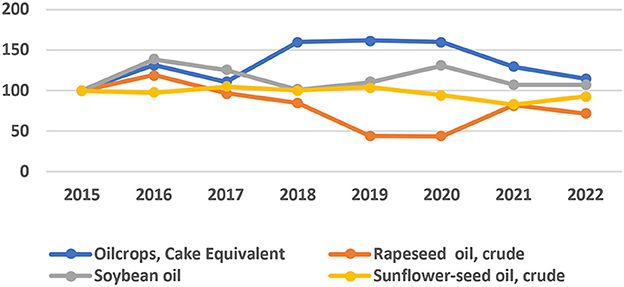
Figure 1. Oil production in Serbia (2015 = 100). Source: FAOSTAT, 2025.
3.2 Foreign trade, comparative advantages and specialization level
Oil crops make up a significant part of the total agri-food export from Serbia, that is, on average for the analyzed period, oil crops make up 10% of agri-food export (Figure 2). The value of oil crops exports tends to grow, and in recent years exceeds the value of 450 million USD. The value of oil crops imports to Serbia is at a significantly lower level, i.e., in the past few years the value of imports has reached 200 million USD (Figure 3). The import of oil crops participates in the total import of agri-food products with an average of about 4%. In contrast to the export of oil crops, which records a permanent growth rate of the export value, imports are characterized by significant oscillations from year to year, depending on specific years, when there is mainly an increase in the import of unprocessed products.
Analyzing the commodity structure of foreign trade of oil crops (Figure 4), it is evident that in the export value structure, oils dominate with over 50%, followed by oil seeds, while oil cakes are exported in a very small percentage. When it comes to exports by individual types of oil crops, the export of sunflowers dominates, where the export of oil is certainly more significant than from sunflower seeds. Regarding the structure of soybean exports, the trend is very variable, which means that in certain years the export of oil exceeds the export of soybean seeds and vice versa. On average, the export of rapeseed makes up about 13% of the total export of oil crops, and in the structure of rapeseed exports from Serbia, the export of rapeseed seed dominates. In the commodity structure of importing oil crops, the situation is different than in the case of export. The import of oil seeds dominates, while the import of oil cakes and oils is significantly smaller. Imports vary significantly by year, and in recent years soyabean seed has had a higher import value than sunflower seed. Imports of rapeseed into Serbia are minor.
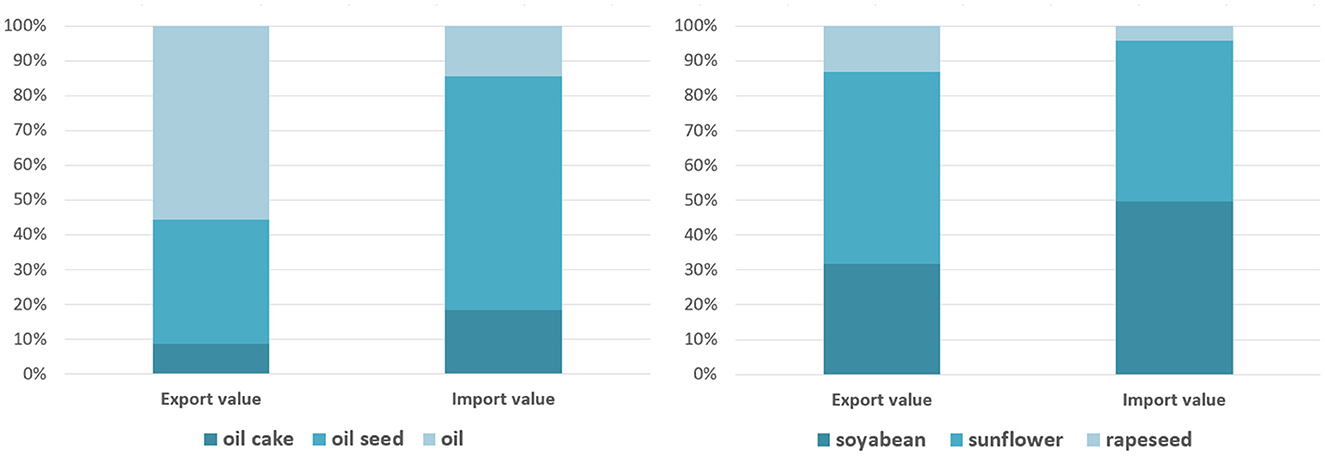
Figure 4. Commodity structure of foreign trade of oil crops of Serbia. Source: The authors' calculations.
The regional structure of oil crops exports (Figure 5) shows that in the analyzed period, the largest part of exports was made to EU countries (about 63%), while about 29% of the total export of all oil crops was exported to the countries of the region (CEFTA). Individually, the highest value of oil crops exports was realized in Bosnia and Herzegovina, where 19% of the total oil crops exports were exported in the analyzed period. The most significant export of oil crops to Bosnia and Herzegovina is sunflower oil (over 50% of all oil crops exported to this country), followed by the export of sunflower seed, which accounts for 40% of oil crops exported to this country. Over 10% of all oil crops from Serbia are exported to Germany, and the dominant exports are rapeseed (42% of all oil crops in Germany) and soyabean (35% of all oil crops in Germany). More than 10% of the total export of oil crops was also realized to Italy, where sunflower oil cake was the most exported (36% of the total export of oil crops to Italy), followed by the export of sunflower oil, which accounted for 35% of the total export of oil crops to Italy. Croatia is also important for the export of oil crops from Serbia, where about 9% of the total export of oil crops was placed, and sunflower oil was the most exported to Croatia, as much as 71% of the total export of all oil crops from Serbia in the analyzed period.
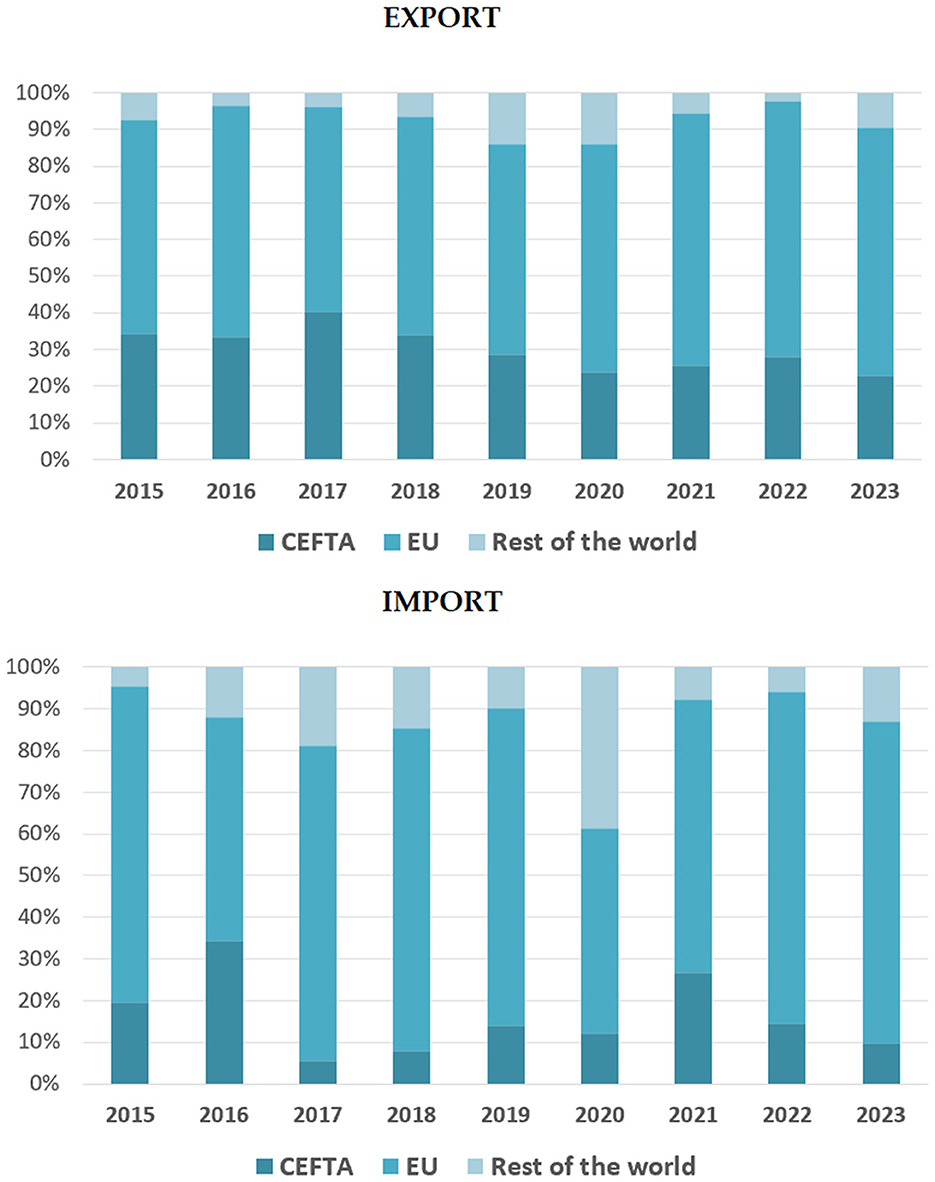
Figure 5. Regional structure of foreign trade of oil crops of Serbia. Source: The authors' calculations.
The regional structure of oil crops imports (Figure 5) shows that in the analyzed period the largest part of imports was realized from EU countries (about 73%), while about 14% of the total import of all oil crops was imported from the countries of the region (CEFTA). Oil crops were mainly imported from Croatia, Hungary, Romania and Bosnia and Herzegovina, as 63% of the total import of oil crops comes from these four countries. Form Croatia 89% of the total import of oil crops is soyabean seed. In imports from Hungary dominate oils: soyabean and sunflower oils accounted for over 60% of oil crops imported from Hungary. On the other hand, soyabean cake was the most imported from Bosnia and Herzegovina, i.e., about 60% of the import of all oil crops from Bosnia and Herzegovina is soyabean cake. From Romania sunflower seed was the most imported, as much as 46% of all oil crops imported from this country. Analyzing the regional structure of imports, as is the case with exports, trade is highly specialized with certain partners.
Revealed comparative advantages of oil crops in Serbia using standard Balassa methodology showed that sunflower has the highest level of RCA (Table 2), while rapeseed and soyabean have slight comparative advantages. Looking at the type of product being analyzed, oils have the greatest comparative advantages, while oil cakes have no comparative advantages. Sunflower oil has the most comparative advantages (average RCA 10.52), and quite significant comparative advantages are achieved by soyabean oil (average RCA 5.14). Among oil seeds, the best situation is with sunflower seeds (average RCA 12.26), although in recent years a decline in comparative advantages has been observed. Of the oil cakes, only the sunflower cake has significant RCA.
The analysis of comparative advantages using the LFI index (Table 3) enables more complete results, due to the wider scope and import of oil crops, that is, due to the symmetry of the scope. LFI shows relatively similar results as the traditional Balassa index RCA. It is observed that the LFI is the highest for sunflower, followed by soyabean, while the lowest LFI is for rapeseed (if oil cakes, oil seeds and oils together are considered) (Table 2). When it comes to the type of product, LFI is certainly the best in oils, namely sunflower oil, followed by soyabean oil. In oil seeds, the highest LFI is sunflower seed. Unlike the RCA methodology, the LFI methodology shows a higher level of comparative advantages with sunflower oil than is the case with sunflower seeds, precisely because of the import side. Oil cakes achieve slight comparative advantages measured by LFI, mostly sunflower oil cakes.
In GLIIT of oil crops in Serbia (Figure 6), it is observed that the market of Serbia is relatively well integrated with the world market, as well as with the market of EU countries and CEFTA countries. The situation is best when looking at GLIIT with EU countries, and the trend with the EU is followed and analyzed when overall integration is considered. The average GLIIT for the period analyzed for the EU countries is 37.65%, while the integration with CEFTA countries is on average at the level of 17.95%.
4 Discussion
Research shows that there is turbulence in the market, which opens additional space for improving competitive positions. To boost the competitiveness of oil crops in Serbia, it is necessary to:
• Find new sunflower oil markets to enable stable exports under the most favorable conditions in cases where the nearest markets are saturated.
• Gradually developing organic soybeans production is expected to enable organic meat production for the European market or at least organic feed for livestock.
• Develop a system of state support to produce biodiesel that can be an adequate alternative in the conditions of a crisis on the fuel market to satisfy domestic or foreign demand. In this way, rapeseed production can become more attractive for farmers with an undeniable positive environmental effect.
In addition to climate factors, as well as the production decisions of farmers that affect the capacities of Serbia's oil crop supply on the global market, the Deep and Comprehensive Free Trade Area between the EU and Ukraine certainly had a significant influence. Considering sunflowers, Baryshpolets and Devadoss (2021) concluded that Ukraine benefits the most from this agreement. Namely, Ukraine is one of the leading countries in the world when sunflower oil production and export are concerned (Hamulczuk et al., 2021). Ukrainian sunflower oil exports to the EU increased by 80 percent, causing the EU's domestic prices for seeds and oil to decline as the EU demands fewer seeds for crushing. Since Ukraine exports more sunflower oil to the EU and less to India, China, and Turkey, that could be an opportunity for other countries to compete in those markets. Access to these markets can further contribute to the diversification of Serbia's foreign trade and reduce dependence on traditional markets. Considering the stable yield of sunflowers and the competitive price of production in Serbia, domestic producers can respond to the demands of these markets.
Serbia is the regional leader in the production of oil crops, which is primarily a consequence of exceptionally favorable agri-ecological conditions in the northern part of the country, i.e., in Autonomna Pokrajina Vojvodina, where over 90% of Serbian production of these crops is concentrated (Statistical Office of the Republic of Serbia, 2025). Plain and high-quality soil provide exceptional conditions for growing sunflowers, soybeans and rapeseed. In this regard, the position of the Banat (eastern part of Vojvodina) stands out, where due to the lower volume of precipitation, oil crops have an advantage over other field crops. Vojvodina is otherwise a region with more intensive agricultural production and commercially oriented agricultural farms, where a significant part of oil crops production is located (Zekić et al., 2021).
Growing demand is the primary driver of the organic food market's development, which creates opportunities for growth within the framework of sustainable agriculture (Golebiewski, 2024). Organic soybean acreage and production in the EU have increased up to 2022 and imports of organic soybeans from non-EU countries also rose sharply (European Union, 2023a). In Serbia, soybean production based on organic principles has been successfully practiced for many years, and the area under cultivation has increased fivefold in the last 10 years, following the trend in the EU (Golijan Pantović et al., 2024). Whilst there is a substantial local market for soybean in Serbia, one third of soybean ends up in export, such as soybean meal, soybeans, oil, a component of the exported animal feed, or, after processing, as highly valued products for human nutrition and other purposes (concentrates, flours) (Živkov et al., 2016), and more than 80% of the exported quantities are exports to the EU market (Statistical Office of the Republic of Serbia, 2025). The EU livestock sector relies on imported soybeans as a feed source (Karlsson et al., 2021), with the Green Deal leading to an increasing focus on organic meat production, it will certainly lead to substantial changes in the meat market in the EU (especially beef) in the forthcoming decades (Kučevi et al., 2023). This is also evidenced by the fact that in the last 2 years organic meat and eggs have been the categories with the largest increase in annual sales, with registered growth (+91%) of organic meat consumption (European Union, 2023b). In line with the trend, demand for organic feed is also increasing. Serbia can take advantage of this trend on the EU market to increase organic soybean production and target the growing EU animal feed or meat market. However, sustainable development and emission reductions in supply chains remain critical challenges that will shape the future of international trade in organic products (Golebiewski, 2024).
Biodiesel has garnered increasing attention in recent years due to its environmental benefits and the fact that it is produced from renewable sources, including vegetable oils and waste fats (Ma and Hanna, 1999). As an alternative fuel, it represents a potential solution for reducing dependence on fossil fuels and mitigating the negative environmental impacts. However, biodiesel faces particular challenges that limit its widespread application. Among the main disadvantages are higher production costs compared to conventional diesel fuel, a lower energy content per unit volume, and emissions of nitrogen oxides during combustion, which can contribute to air pollution (Gebremariam and Marchetti, 2018). Despite the mentioned limitations, biodiesel is still considered a fuel that can contribute to multiple benefits. In addition to environmental benefits, such as biodegradability, lower toxicity, and lower greenhouse (Živković and Veljković, 2018). Therefore, biodiesel is perceived as a viable alternative that deserves further research and technological improvements.
Rapeseed is widely used in energy production. However, Van Duren et al. (2015) concluded that the energy efficiency of rapeseed biodiesel is low, and unless there is major technological progress in the production process, replacing fossil fuels by biofuels from rapeseed is not a feasible option. On the other hand, Qiu et al. (2011) showed that the properties of obtained biodiesel from mixed rapeseed and soybean oil are close to commercial diesel fuel and is rated as a realistic fuel as an alternative to diesel. Therefore, this sector is still in a developmental phase, and the scientific community is relatively divided. In Serbia, biodiesel production is at very low level. Kiss et al. (2024) showed that approximately 353,000 hectares of land are available for producing raw materials for biodiesel production without compromising the domestic food supply which can pro-vide up to 324,000 tons of biodiesel annually, equivalent to 15.2% of the total domestic diesel fuel consumption for transportation. Due to relatively favorable agri-environmental conditions for oil crop production, especially rapeseed and soybeans, biodiesel should be a viable option for developing this sector in Serbia.
5 Conclusion
Serbia is an important producer of oil crops in Europe, especially soybeans and sunflowers, and it also has significant processing capacities to produce oil. In recent years, total production has been declining due to the pronounced instability of the global oilseed market, and the preference for traditional crops such as wheat and corn. Also, the crisis in Ukraine, and the conclusion of the Free Trade Agreement between the EU and Ukraine, had a significant impact on the oilseeds market in Serbia.
Oil crops make up as much as 10% of total agri-food exports from Serbia, and there is a tendency to increase the value of exports. Over 50% of exports are oils, primarily sunflower oil. The most important partner when it comes to exports are the EU countries, followed by the countries of the region (CEFTA). When it comes to the comparative advantages of Serbia in the export of oil crops, sunflower records the highest levels of revealed comparative advantages, and both sunflower seeds and sunflower oil have high values of this indicator. Also, a good integration of the oil crops market can be observed, both with the world market and with the markets of the EU and CEFTA countries.
To enhance the competitiveness of oil crops in Serbia, policymakers are recommended to support the gradual development of organic soybean production to enable organic livestock feed or meat for export, explore new international markets for sunflower oil to ensure stable and favorable export conditions, and establish incentives for biodiesel production from rapeseed as a strategic response to fuel market disruptions—thereby boosting domestic energy security and promoting environmentally sustainable agriculture.
It is necessary to point out that this research is not without limitations. It is certain that including the factors that shape competitiveness using econometric models would provide a more detailed explanation of competitive positions in the international market. This will be the subject of future research, with a more detailed look at each individual product from this section.
Data availability statement
The raw data supporting the conclusions of this article will be made available by the authors, without undue reservation.
Author contributions
BM: Conceptualization, Investigation, Methodology, Visualization, Writing – original draft, Writing – review & editing. DÐ: Investigation, Methodology, Writing – original draft, Writing – review & editing. SZ: Conceptualization, Methodology, Writing – original draft, Writing – review & editing. ŽJ: Investigation, Methodology, Supervision, Writing – original draft, Writing – review & editing.
Funding
The author(s) declare that financial support was received for the research and/or publication of this article. This research was supported by the Science Fund of the Republic of Serbia, #10911, Potentials for improving the competitiveness of the agri-food sector in the function of sustainable economic development–POT4food.
Conflict of interest
The authors declare that the research was conducted in the absence of any commercial or financial relationships that could be construed as a potential conflict of interest.
Generative AI statement
The author(s) declare that no Gen AI was used in the creation of this manuscript.
Any alternative text (alt text) provided alongside figures in this article has been generated by Frontiers with the support of artificial intelligence and reasonable efforts have been made to ensure accuracy, including review by the authors wherever possible. If you identify any issues, please contact us.
Publisher's note
All claims expressed in this article are solely those of the authors and do not necessarily represent those of their affiliated organizations, or those of the publisher, the editors and the reviewers. Any product that may be evaluated in this article, or claim that may be made by its manufacturer, is not guaranteed or endorsed by the publisher.
References
Akimowicz, M., Del Corso, J.-P., Gallai, N., and Képhaliacos, C. (2021). Adopt to adapt? Farmers' varietal innovation adoption in a context of climate change: the case of sunflower hybrids in France. J. Clean. Product. 279:123654. doi: 10.1016/j.jclepro.2020.123654
Ambroziak, Ł. (2024). Intra-industry trade in agri-food products: the case of Poland and Ukraine. Eur. Res. Stud. J. doi: 10.35808/ersj/3522
Babec, B., Šeremešić, S., Hladni, N., Cuk, N., Stanisavljević, D., and Rajković, M. (2021). Potential of sunflower-legume intercropping: a way forward in sustainable production of sunflower in temperate climatic conditions. Agronomy 11:2381. doi: 10.3390/agronomy11122381
Balassa, B. (1965). Trade liberalisation and “revealed” comparative advantage. Manch. Sch. 33, 99–123. doi: 10.1111/j.1467-9957.1965.tb00050.x
Balogh, J. M. (2024). “Agri-food trade competitiveness in Latin America and the Caribbean region”, in Value chain dynamics in a biodiverse environment: Advances in biodiversity, sustainability, and agri-food supply chain development, eds. K. Mattas, G. Baourakis, C. Zopounidis, and C. Staboulis, (Cham: Springer Nature Switzerland), 15–36. doi: 10.1007/978-3-031-49845-9_2
Baryshpolets, A., and Devadoss, S. (2021). The effects of EU–Ukraine free trade agreement on the world's sunflower complex. Eur. Rev. Agricult. Econ. 48, 1187–1223. doi: 10.1093/erae/jbab017
Birovljev, J., Matkovski, B., and Cetković, B. (2015). The competitiveness of the Serbian agri-food products on the market of countries in the region. Anal. Ekonom. fakult. Subotici 33, 61–78. doi: 10.2298/JAS2303347
Božić, D., and Nikolić, M. M. (2016). Obeležja spoljnotrgovinske razmene poljoprivredno-prehrambenih proizvoda Srbije: characteristics of Serbian foreign trade of agricultural and food products. Marketing 47, 293–304. doi: 10.5937/markt1604293B
Brankov, T., and Matkovski, B. (2022). Is a food shortage coming to the Western Balkans? Foods 11:3672. doi: 10.3390/foods11223672
Brankov, T., Matkovski, B., Jeremić, M., and Ðurić, I. (2021). Food self-sufficiency of the SEE countries; is the region prepared for a future crisis? Sustainability 13:8747. doi: 10.3390/su13168747
Brkić, S., Kastratović, R., and Salkica, M. A. (2021). Analysis of intra-industry trade in agri-food products between Bosnia and Herzegovina and the European Union. South East Eur. J. Econ. Buss.16, 53–67. doi: 10.2478/jeb-2021-0014
Cuzović, Ð., and Sokolov-Mladenović, S. (2021). Agricultural intra-industry trade in Serbia. TEME 0, 349–366. doi: 10.22190/TEME200210019C
Dimitrijevć, M. S., Cakajac, B. M., and Milojević, I. R. (2023). Competitiveness of the agri-food sector of the Republic of Serbia. J. Agricult. Sci. 68, 347–361.
Ðokić, D., Jurjević, Ž., Popović, R., and Savić, M. (2019). Is there a correlation between economic and energy use efficiency in soybean production? Custos e Agronegócio 15, 489–505.
European Union (2023a). EU imports of organic agri-food products - Analytical Brief N° 2. DG Agriculture and Rural Development, Brussels. Available online at: https://agriculture.ec.europa.eu/system/files/2023-07/analytical-brief-2-eu-organic-imports-2022_en.pdf (Accessed May 10, 2025).
European Union (2023b). Organic farming in the EU. DG Agriculture and Rural Development, Brussels.Available online at: https://agriculture.ec.europa.eu/document/download/df01a3c7-c0fb-48f1-8eca-ce452ea4b8c2_en?filename=agri-market-brief-20-organic-farming-eu_en.pdf (Accessed May 10, 2025).
FAOSTAT. (2025). FAOSTAT . Food and Agriculture Organization of the United Nations. Available online at: https://www.fao.org/faostat/en/ (Accessed February 8, 2025).
Gebremariam, S. N., and Marchetti, J. M. (2018). Economics of biodiesel production. Energy Conv. Manag. 168, 74–84. doi: 10.1016/j.enconman.2018.05.002
Golebiewski, J. (2024). Changes in the import of organic products to the European Union between 2018 and 2023. Ann. Polish Assoc. Agricult. Agribus. Econ. 26, 58–70. doi: 10.5604/01.3001.0054.8685
Golijan Pantović, J., Dimitrijević, B., Sečanski, M., and Gordanić, S. (2024). Analysis of the state of organic soybean production in Serbia. Acta Agricult. Serbica 29, 67–73. doi: 10.5937/AASer2458067G
Government of the Republic of Serbia (2014). Strategy for Agriculture And Rural Development of Republic of Serbia 2014–2024.
Grahovac, N., Lužaić, T., Živančev, D., Stojanović, Z., Ðurović, A., Romani,ć, R., et al. (2024). Assessing nutritional characteristics and bioactive compound distribution in seeds, oil, and cake from confectionary sunflowers cultivated in Serbia. Foods 13:1882. doi: 10.3390/foods13121882
Grubel, H. G., and Lloyd, P. J. (1975). Intra-Industry Trade: The Theory And Measurement Of International Trade In Differentiated Products. London: Wiley.
Hamulczuk, M., Makarchuk, O., and Kuts, T. (2021). Time-varying integration of Ukrainian sunflower oil market with the EU market. AGRIS on-line Papers Econ. Inform. 13, 35–47. doi: 10.7160/aol.2021.130304
Jambor, A., and Babu, S. (2016). Competitiveness of Global Agriculture. Cham: Springer Cham. doi: 10.1007/978-3-319-44876-3
Jaradat, A. A. (2016). “Breeding oilseed crops for climate change”, in Breeding Oilseed Crops for Sustainable Production, ed. S. K. Gupta (St. Paul, MN: Academic Press), 421–472. doi: 10.1016/B978-0-12-801309-0.00018-5
Jurjević, Ž., Zekić, S., Ðokić, D., and Matkovski, B. (2021). Regional spatial approach to differences in rural economic development: insights from Serbia. Land 10:1211. doi: 10.3390/land10111211
Karaman, S., Özkan, B., and Yigit, F. (2023). Export competitiveness of Türkiye agri-food products in the European Union and the Shanghai Cooperation markets. J. Agricult. Sci. 29, 665–676. doi: 10.15832/ankutbd.1029516
Karlsson, J. O., Parodi, A., Van Zanten, H. H., Hansson, P. A., and Röös, E. (2021). Halting European Union soybean feed imports favours ruminants over pigs and poultry. Nat. Food 2, 38–46. doi: 10.1038/s43016-020-00203-7
Kiss, F., Ðurišić-Mladenović, N., Tomić, M., and Marjanović-Jeromela, A. (2024). Biodiesel production potential from oilseed crops in Serbia. Contemp. Agricult. 73, 84–94. doi: 10.2478/contagri-2024-0011
Krstić, M., and Gawel, A. (2023). Improving the competitiveness – determinants and solutions for quality of local business conditions. Int. J. Qual. Res. 17, 529–554. doi: 10.24874/IJQR17.02-15
Krstić, M. (2023). Climate change in the EU: analysis by clustering and regression. Ser. J. Manag. 18, 111–132. doi: 10.5937/sjm18-43601
Kučević, D., Brka, M., Plavšić, M., Cobanović, K., Papović, T., and Gantner, V. (2023). Organic beef production as a sustainable solution for the EU market: a case study of the Republic of Serbia. Biotechnol. Anim. Husb. 39, 1–14. doi: 10.2298/BAH2301001K
Lafay, G. (1992). “The measurement of revealed comparative advantages”, in International trade modeling. Papers Published in This Book Were Selected From the Best Communications presented at the XXVII Conference of the Applied Econometrics Association on International Trade held in Montreal, September 1989, eds. M. G. Dagenais, P.-A. Muet. doi: 10.1007/978-1-4757-2150-8_10
Ma, F., and Hanna, M. A. (1999). Biodiesel production: a review. Biores. Technol. 70, 1–15. doi: 10.1016/S0960-8524(99)00025-5
Matkovski, B., Jeremić, M., Ðokić, D., and Jurjević, Ž. (2020). Serbia oil crops export potentials. Rat. Povr. 57, 14–21. doi: 10.5937/ratpov57-23321
Matkovski, B., Radovanov, B., and Zekić, S. (2018b). The effects of foreign agri-food trade liberalization in South East Europe. Ekon. čas. 66, 945–966.
Matkovski, B., Zekić, S., Ðokić, D., Jurjević, Ž., and Ðurić, I. (2022). Export competitiveness of agri-food sector during the EU integration process: evidence from the Western Balkans. Foods 11:10. doi: 10.3390/foods11010010
Matkovski, B., Zekić, S., Jurjević, Ž., and Ðokić, D. (2021). The agribusiness sector as a regional export opportunity: evidence for the Vojvodina region. Int. J. Emerg. Markets 17, 2468–2489. doi: 10.1108/IJOEM-05-2020-0560
Matkovski, B., Zekić, S., Savić, M., and Radovanov, B. (2018a). Trade of agri-food products in the EU enlargement process: Evidence from the Southeastern Europe. Agricult. Econ. 64, 357–366. doi: 10.17221/134/2017-AGRICECON
Mizik, T. (2021). Agri-food trade competitiveness: a review of the literature. Sustainability 13, 1–14. doi: 10.3390/su132011235
Novaković, T., Ðokić, D., Tatić, M., Matkovski, B., and Ðrić, I. (2025). Decomposition of total factor productivity in the dairy sector: comparative analysis of Serbia vs. European Union. Strat. Manag. doi: 10.5937/StraMan2500002N. [Epub ahead of print].
Popović, R., Jurjević, Ž., and Ðokić, D. (2018). Exploring the drivers of efficiency in organic and conventional soybean production. Cust. Agron. 14, 214–229.
Qiu, F., Li, Y., Yang, D., Li, X., and Sun, P. (2011). Biodiesel production from mixed soybean oil and rapeseed oil. Appl. Energy 88, 2050–2055. doi: 10.1016/j.apenergy.2010.12.070
Ramli, U. S., Tang, M., Quant, P. A., Guschina, I. A., Fawcett, T., and Harwood, J. L. (2014). Informed metabolic engineering of oil crops using control analysis. Biocat. Agricult. Biotechnol. 3, 49–52. doi: 10.1016/j.bcab.2013.12.001
Rotundo, J. L., Marshall, R., McCormick, R., Truong, S. K., Styles, D., Gerde, J. A., et al. (2024). European soybean to benefit people and the environment. Sci. Rep. 14:7612. doi: 10.1038/s41598-024-57522-z
Semerci, A., and Yurt, I. (2023). Cost and gross profit analysis in oily sunflower (Helianthus annuus, L.) production: the case of Canakkale province, Turkey. Custos e@gronegócio on line 19, 2–39.
Statistical Office of the Republic of Serbia (2025). Database. Available online at: https://www.stat.gov.rs/en-US/ (Accessed February 1, 2025).
Stoicea, P., Chiurciu, I. A., Soare, E., Iorga, A. M., Dinu, T. A., Tudor, V. C., et al. (2022). Impact of reducing fertilizers and pesticides on sunflower production in Romania vs. EU countries. Sustainability 14:8334. doi: 10.3390/su,14148334
U. N Comtrade Database (2025). Available online at: https://comtradeplus.un.org/(Accessed) January 23, 2025).
United Nations Statistics Division. (2024). Standard International Trade Classification. Available online at: https://unstats.un.org/(Accessed November 23, 2024).
Van Duren, I., Voinov, A., Arodudu, O., and Firrisa, M. T. (2015). Where to produce rapeseed biodiesel and why? Mapping European rapeseed energy efficiency. Ren. Energy 74, 49–59. doi: 10.1016/j.renene.2014.07.016
Voora, V., Larrea, K., and Bermudez, S. (2020). Global market report: Soybeans. International Institute for Sustainable Development (IISD). Available online at: https://www.iisd.org/publications/report/global-market-report-soybeans (Accessed March 3, 2025).
Zekić, S., Kleut, Ž., Matkovski, B., and Ðokić, D. (2018). Determining agricultural impact on environment: evidence for EU-28 and Serbia. Outlook on Agricult. 47, 116–124. doi: 10.1177/0030727018768016
Zekić, S., Matkovski, B., and Ðokić, D. (2022). “Open Balkan and regional competitiveness of export of agri-food products,” in Jahorina Business Forum 2022 (Pale: Faculty of Economics Pale).
Zekić, S., Matkovski, B., Jeremić, M., Ðokić, D., and Jurjević, Ž. (2021). “Production potentials and exports of the food industry of Vojvodina,” in Institute of Agricultural Economics, eds. J. Subić, P. Vuković, and A. Vasile (Belgrade), 315–324
Živkov, G., Teofilović, N., and Tar, D. (2016). Effects of liberalization of Law on GMO on the soybean market in the Republic of Serbia. Danube Soya-Regional Center Novi Sad and SEEDEV.Available online at: https://www.donausoja.org/wp-content/uploads/2022/02/Effects_of_liberalization_of_Law_on_GMO_on_soybean_market_in_Serbia.pdf (Accessed May 15, 2025).
Keywords: oil crops, competitiveness, Serbia, revealed comparative advantages, Grubel-Lloyd
Citation: Matkovski B, Ðokić D, Zekić S and Jurjević Ž (2025) Competitiveness of oil crops production: evidence from Serbia. Front. Sustain. Food Syst. 9:1651410. doi: 10.3389/fsufs.2025.1651410
Received: 21 June 2025; Accepted: 03 September 2025;
Published: 03 October 2025.
Edited by:
Daniel Arruda Coronel, Universidade Federal de Santa Maria, BrazilReviewed by:
Mehmet Emin Yardimci, Kocaeli University, TürkiyeSladana Vujičić, Faculty of Business Econmics and Entrepreneurship, Serbia
Copyright © 2025 Matkovski, Ðokić, Zekić and Jurjević. This is an open-access article distributed under the terms of the Creative Commons Attribution License (CC BY). The use, distribution or reproduction in other forums is permitted, provided the original author(s) and the copyright owner(s) are credited and that the original publication in this journal is cited, in accordance with accepted academic practice. No use, distribution or reproduction is permitted which does not comply with these terms.
*Correspondence: Bojan Matkovski, Ym9qYW4ubWF0a292c2tpQGVmLnVucy5hYy5ycw==
 Bojan Matkovski
Bojan Matkovski Danilo Ðokić
Danilo Ðokić
